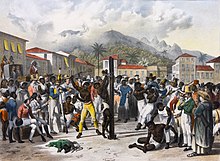
A | B | C | D | E | F | G | H | CH | I | J | K | L | M | N | O | P | Q | R | S | T | U | V | W | X | Y | Z | 0 | 1 | 2 | 3 | 4 | 5 | 6 | 7 | 8 | 9
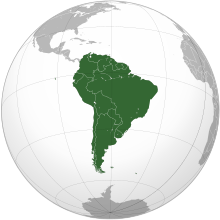 | |
| Area | 17,840,000 km2 (6,890,000 sq mi) (4th) |
|---|---|
| Population | 434,254,119 (2021; 5th)[1][2] |
| Population density | 21.4/km2 (56.0/sq mi) |
| GDP (PPP) | $7.61 trillion (2022 est; 5th)[3] |
| GDP (nominal) | $3.62 trillion (2022 est; 4th)[4] |
| GDP per capita | $8,340 (2022 est; 5th)[5] |
| Religions |
|
| Demonym | South American |
| Countries | |
| Dependencies | |
| Languages | |
| Time zones | UTC−02:00 to UTC−05:00 |
| Largest cities | |
| UN M49 code | 005 – South America419 – Latin America and the Caribbean019 – Americas001 – World |

South America is a continent[h] entirely in the Western Hemisphere[i] and mostly in the Southern Hemisphere, with a considerably smaller portion in the Northern Hemisphere. It can also be described as the southern subregion of the Americas.
South America is bordered on the west by the Pacific Ocean and on the north and east by the Atlantic Ocean; North America and the Caribbean Sea lie to the northwest. The continent is generally taken to include twelve sovereign states: Argentina, Bolivia, Brazil, Chile, Colombia, Ecuador, Guyana, Paraguay, Peru, Suriname, Uruguay, and Venezuela; two dependent territories: the Falkland Islands and South Georgia and the South Sandwich Islands;[j] and one internal territory: French Guiana.[k] In addition, the ABC islands of the Kingdom of the Netherlands, Ascension Island (dependency of Saint Helena, Ascension and Tristan da Cunha, a British Overseas Territory), Bouvet Island (dependency of Norway), Panama, and Trinidad and Tobago may also be considered parts of South America.
South America has an area of 17,840,000 square kilometers (6,890,000 sq mi). Its population as of 2021[update] has been estimated at more than 434 million.[1][2] South America ranks fourth in area (after Asia, Africa, and North America) and fifth in population (after Asia, Africa, Europe, and North America). Brazil is by far the most populous South American country, with almost half of the continent's population, followed by Colombia, Argentina, Venezuela and Peru. In recent decades, Brazil has also generated half of the continent's GDP and has become the continent's first regional power.[8]
Most of the population lives near the continent's western or eastern coasts while the interior and the far south are sparsely populated. The geography of western South America is dominated by the Andes mountains; in contrast, the eastern part contains both highland regions and vast lowlands where rivers such as the Amazon, Orinoco and Paraná flow. Most of the continent lies in the tropics, except for a large part of the Southern Cone located in the middle latitudes.
The continent's cultural and ethnic outlook has its origin with the interaction of Indigenous peoples with European conquerors and immigrants and, more locally, with African slaves. Given a long history of colonialism, the overwhelming majority of South Americans speak Spanish or Portuguese, and societies and states are rich in Western traditions. Relative to Europe, Asia and Africa, post-1900 South America has been a peaceful continent with few wars.[9][10][l]
Geography
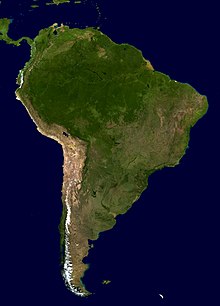
South America occupies the southern portion of the Americas. The continent is generally delimited on the northwest by the Darién watershed along the Colombia–Panama border, although some may consider the border instead to be the Panama Canal. Geopolitically[12] and geographically, all of Panama – including the segment east of the Panama Canal in the isthmus – is typically included in North America alone[13][14][15] and among the countries of Central America.[16][17] Almost all of mainland South America sits on the South American Plate.
South America is home to several superlatives, including, the world's second highest uninterrupted waterfall, Angel Falls in Venezuela; the highest single-drop waterfall Kaieteur Falls in Guyana; the largest river by volume, the Amazon River; the longest mountain range, the Andes (whose highest mountain is Aconcagua at 6,962 m or 22,841 ft); the driest non-polar place on earth, the Atacama Desert;[18][19][20] the wettest place on earth, López de Micay in Colombia; the largest rainforest, the Amazon rainforest; the highest capital city, La Paz, Bolivia; the highest commercially navigable lake in the world, Lake Titicaca; and, excluding research stations in Antarctica, the world's southernmost permanently inhabited community, Puerto Toro, Chile.
South America's major mineral resources are gold, silver, copper, iron ore, tin, and petroleum. These resources have brought high income to its countries, especially in times of war or of rapid economic growth by industrialized countries elsewhere. However, the concentration in producing one, or few major export commodities has often hindered the development and diversification of its economies. The fluctuation in the price of commodities in international markets has led historically to major highs and lows, booms and busts, in the economies of South American states, often causing political instability.[21] This has lead for calls to diversify production and increase trade within South America itself.[21]
Brazil is the largest country in South America, covering a little less than half of the continent's land area and encompassing around half of the continent's population.[22] The remaining countries and territories are divided among four subregions: the Andean states, Caribbean South America, The Guianas, and the Southern Cone.[23]
Outlying islands
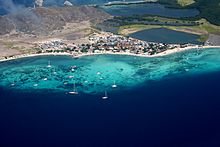
Physiographically, South America also includes some of the nearby islands. The Dutch ABC islands (Aruba, Bonaire, and Curaçao), the islands of Trinidad and Tobago (Trinidad Island and Tobago Island etc.), the State of Nueva Esparta, and the Federal Dependencies of Venezuela sit on the northern portion of the South American continental shelf and are sometimes considered parts of the continent. Geopolitically, all the island countries and territories in the Caribbean have generally been grouped as a subregion of North America instead. By contrast, Aves Island (administered by Venezuela) and the Archipelago of San Andrés, Providencia and Santa Catalina (San Andrés Island, Providencia Island, and Santa Catalina Island etc., which are administered by Colombia) are politically parts of South American countries but physiographically parts of North America.[15][24][25]
Other islands often associated with geopolitical South America are the Chiloé Archipelago and Robinson Crusoe Island (both administered by Chile), Easter Island (culturally a part of Oceania, also administered by Chile),[26] the Galápagos Islands (administered by Ecuador, sometimes considered part of Oceania),[26][27][28] and Tierra del Fuego (split between Argentina and Chile). In the Atlantic Ocean, Brazil administers Fernando de Noronha, Trindade and Martim Vaz, and the Saint Peter and Saint Paul Archipelago, while the Falkland Islands (Spanish: Islas Malvinas) and South Georgia and the South Sandwich Islands (biogeographically and hydrologically associated with Antarctica)[29] have been administered as two British Overseas Territories under the Crown, whose sovereignty over the islands is disputed by Argentina.
Special cases
An isolated volcanic island on the South American Plate, Ascension Island is geologically a part of South America.[30] Administered as a dependency of Saint Helena, Ascension and Tristan da Cunha, the island is geopolitically a part of Africa.
Climate
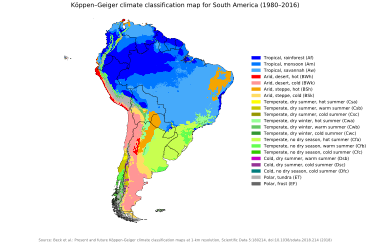
All of the world's major climate zones are present in South America.[32]
The distribution of the average temperatures in the region presents a constant regularity from the 30° of latitude south, when the isotherms tend, more and more, to be confused with the degrees of latitude.[33]
In temperate latitudes, winters and summers are milder than in North America. This is because the most extensive part of the continent is in the equatorial zone (the region has more areas of equatorial plains than any other region),[33] therefore giving the Southern Cone more oceanic influence, which moderates year round temperatures.
The average annual temperatures in the Amazon basin oscillate around 27 °C (81 °F), with low thermal amplitudes and high rainfall indices. Between the Maracaibo Lake and the mouth of the Orinoco, predominates an equatorial climate of the type Congolese, that also includes parts of the Brazilian territory.[33]
The east-central Brazilian plateau has a humid and warm tropical climate. The northern and eastern parts of the Argentine pampas have a humid subtropical climate with dry winters and humid summers of the Chinese type, while the western and eastern ranges have a subtropical climate of the dinaric type. At the highest points of the Andean region, climates are colder than the ones occurring at the highest point of the Norwegian fjords. In the Andean plateaus, the warm climate prevails, although it is tempered by the altitude, while in the coastal strip, there is an equatorial climate of the Guinean type. From this point until the north of the Chilean coast appear, successively, Mediterranean oceanic climate, temperate of the Breton type and, already in Tierra del Fuego, cold climate of the Siberian type.[33]
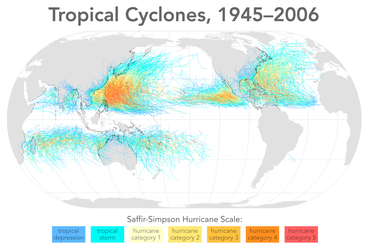
The distribution of rainfall is related to the regime of winds and air masses. In most of the tropical region east of the Andes, winds blowing from the northeast, east and southeast carry moisture from the Atlantic, causing abundant rainfall. However, due to a consistently strong wind shear and a weak Intertropical Convergence Zone, South Atlantic tropical cyclones are rare.[34] In the Orinoco Llanos and in the Guianas Plateau, the precipitation levels go from moderate to high. The Pacific coast of Colombia and northern Ecuador are rainy regions, with Chocó in Colombia being the rainiest place in the world along with the northern slopes of Indian Himalayas.[35] The Atacama Desert, along this stretch of coast, is one of the driest regions in the world. The central and southern parts of Chile are subject to extratropical cyclones, and most of the Argentine Patagonia is desert. In the Pampas of Argentina, Uruguay and South of Brazil the rainfall is moderate, with rains well distributed during the year. The moderately dry conditions of the Chaco oppose the intense rainfall of the eastern region of Paraguay. In the semiarid coast of the Brazilian Northeast the rains are linked to a monsoon regime.[33]
Important factors in the determination of climates are sea currents, such as the current Humboldt and Falklands. The equatorial current of the South Atlantic strikes the coast of the Northeast and there is divided into two others: the current of Brazil and a coastal current that flows to the northwest towards the Antilles, where there it moves towards northeast course thus forming the most Important and famous ocean current in the world, the Gulf Stream.[33][36]
Fauna
South America is one of the most biodiverse continents on Earth. It is home to many unique species of animals including the llama, anaconda, piranha, jaguar, vicuña, and tapir, and to one of the largest known insects in the world, the Titan beetle. The Amazon rainforests possess high biodiversity, with Brazil estimated to contain 10% of Earth's species.[37] 83% of South America's large mammals (megafauna) became extinct at the end of the Pleistocene around 11,000 years ago as part of the Quaternary extinction event, among the highest of any continent, with the casualties including saber-toothed cats, ground sloths, glyptodonts, gomphotheres, the equines Hippidion and Equus neogeus, and all remaining South American native ungulates.[38]
History
Prehistory
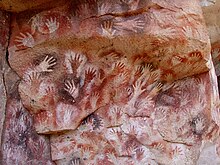
South America is thought to have been first inhabited by humans when people were crossing the Bering Land Bridge (now the Bering Strait) at least 15,000 years ago from the territory that is present-day Russia. They migrated south through North America, and eventually reached South America through the Isthmus of Panama.
Amongst the oldest evidence for human presence in South America is the Monte Verde II site in Chile, suggested to date to around 14,500 years ago.[39] From around 13,000 years ago, the Fishtail projectile point style became widespread across South America, with its disppearance around 11,000 years ago coincident with the disappearance of South America's megafauna.[40] Maize was present in northern South America by around 6,000 years ago.[41]
By 2000 BC, many agrarian communities had been settled throughout the Andes and the surrounding regions. Fishing became a widespread practice along the coast, helping establish fish as a primary source of food. Irrigation systems were also developed at this time, which aided in the rise of an agrarian society.[42]
South American cultures began domesticating llamas, vicuñas, guanacos, and alpacas in the highlands of the Andes circa 3500 BC. Besides their use as sources of meat and wool, these animals were used for transportation of goods.[42]
Pre-Columbian civilizations

The rise of plant growing and the subsequent appearance of permanent human settlements allowed for the multiple and overlapping beginnings of civilizations in South America.
One of the earliest known South American civilizations was at Caral-Supe, on the central Peruvian coast. Though a pre-ceramic culture, the monumental architecture of Caral-Supe created one of the first cities of the world, generally dated to around 3500 BC, at Huaricanga in the Fortaleza area, contemporaneous with the pyramids of Ancient Egypt, one of the oldest-known civilization in the Americas and one of the six sites where civilisation separately originated in the ancient world.[43] Caral-Supe governing class established a trade network and developed agriculture then followed by Chavín by 900 BC, according to some estimates and archaeological finds. Artifacts were found at a site called Chavín de Huantar in modern Peru at an elevation of 3,177 meters (10,423 ft). Chavín civilization spanned 900 BC to 300 BC.
In the central coast of Peru, around the beginning of the 1st millennium AD, Moche (100 BC – 700 AD, at the northern coast of Peru), Paracas and Nazca (400 BC – 800 AD, Peru) cultures flourished with centralized states with permanent militia improving agriculture through irrigation and new styles of ceramic art. At the Altiplano, Tiahuanaco or Tiwanaku (100 BC – 1200 AD, Bolivia) managed a large commercial network based on religion.
Around the 7th century, both Tiahuanaco and Wari or Huari Empire (600–1200, Central and northern Peru) expanded its influence to all the Andean region, imposing the Huari urbanism and Tiahuanaco religious iconography.
The Muisca were the main indigenous civilization in what is now Colombia. They established the Muisca Confederation of many clans, or cacicazgos, that had a free trade network among themselves. They were goldsmiths and farmers.
Other important Pre-Columbian cultures include: the Cañaris (in south central Ecuador), Chimú Empire (1300–1470, Peruvian northern coast), Chachapoyas, and the Aymaran kingdoms (1000–1450, Western Bolivia and southern Peru). Holding their capital at the great city of Cusco, the Inca civilization dominated the Andes region from 1438 to 1533. Known as Tawantin suyu, and "the land of the four regions," in Quechua, the Inca Empire was highly distinct and developed. Inca rule extended to nearly a hundred linguistic or ethnic communities, some nine to fourteen million people connected by a 25,000 kilometer road system. Cities were built with precise, unmatched stonework, constructed over many levels of mountain terrain. Terrace farming was a useful form of agriculture.
The Mapuche in Central and Southern Chile resisted the European and Chilean settlers, waging the Arauco War for more than 300 years.
European colonization
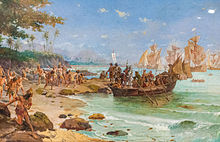
In 1494, Portugal and Spain, the two great maritime European powers of that time, on the expectation of new lands being discovered in the west, signed the Treaty of Tordesillas, by which they agreed, with the support of the Pope, that all the land outside Europe should be an exclusive duopoly between the two countries.[44]
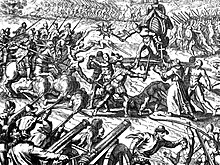
The treaty established an imaginary line along a north–south meridian 370 leagues west of the Cape Verde Islands, roughly 46° 37' W. In terms of the treaty, all land to the west of the line (known to comprise most of the South American soil) would belong to Spain, and all land to the east, to Portugal. As accurate measurements of longitude were impossible at that time, the line was not strictly enforced, resulting in a Portuguese expansion of Brazil across the meridian.
Beginning in the 1530s, the people and natural resources of South America were repeatedly exploited by foreign conquistadors, first from Spain and later from Portugal. These competing colonial nations claimed the land and resources as their own and divided it into colonies.
European infectious diseases (smallpox, influenza, measles, and typhus) – to which the native populations had no immune resistance – caused large-scale depopulation of the native population under Spanish control. Systems of forced labor, such as the haciendas and mining industry's mit'a also contributed to the depopulation. After this, enslaved Africans, who had developed immunities to these diseases, were quickly brought in to replace them.

The Spaniards were committed to converting their native subjects to Christianity and were quick to purge any native cultural practices that hindered this end; however, many initial attempts at this were only partially successful, as native groups simply blended Catholicism with their established beliefs and practices. Furthermore, the Spaniards brought their language to the degree they did with their religion, although the Roman Catholic Church's evangelization in Quechua, Aymara, and Guaraní actually contributed to the continuous use of these native languages albeit only in the oral form.
Eventually, the natives and the Spaniards interbred, forming a mestizo class. At the beginning, many mestizos of the Andean region were offspring of Amerindian mothers and Spanish fathers. After independence, most mestizos had native fathers and European or mestizo mothers.
Many native artworks were considered pagan idols and destroyed by Spanish explorers; this included many gold and silver sculptures and other artifacts found in South America, which were melted down before their transport to Spain or Portugal. Spaniards and Portuguese brought the western European architectural style to the continent, and helped to improve infrastructures like bridges, roads, and the sewer system of the cities they discovered or conquered. They also significantly increased economic and trade relations, not just between the old and new world but between the different South American regions and peoples. Finally, with the expansion of the Portuguese and Spanish languages, many cultures that were previously separated became united through that of Latin American.
Guyana was initially colonized by the Dutch before coming under British control, though there was a brief period during the Napoleonic Wars when it was occupied by the French. The region was initially partitioned between the Dutch, French and British before fully coming under the control of Britain.
Suriname was first explored by the Spanish in the 16th century and then settled by the English in the mid-17th century. It became a Dutch colony in 1667.[45]
Slavery in South America
